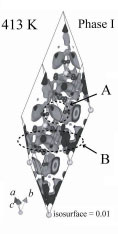00316
Structural and Dynamical Studies on Protonic Conductor K3H(SeO4)2
Institute of Materials and Structure Science, HIgh Energy Accelerator Research Organization* Intense Pulsed Neutron Source Division, Argonne National Laboratory, USA** Graduate school of Engineering and Science, Ibaraki University, Japan*** Research Reactor Institute, Kyoto University, Japan**** Quantum Beam Science Directorate, Japan Atomic Energy Agency, Japan***** Faculty of Engineering, Chiba Institute of Technology, Japan******
○Fumihito Shikanai* Keisuke Tomiyasu* Ryoji Kiyanagi** Masao Yonemura*** Kenji Iwase* Dyah Sulistyanintyas* Tuerxun Wurnisha* Kazuhiro Mori**** Toru Ishigaki***** Itaru Tsukushi****** Susumu Ikeda* Takashi Kamiyama*
Hydrogen-bonded typed crystals of M3X(YO4)2 have attracted much attention due to interesting phenomena in the high-temperature region. Most of the crystals undergo phase transition in the high-temperature, and show over 100 times higher electric conductivities than those at the room-temperature. It has been considered that the higher conductivities were due to the proton transfer in the crystals.
Crystal structures of protonic conductor K3H(SeO4)2 in the phase I (conducting phase) and phase II (room-temperature phase) have been determined using a time-of-flight (TOF) neutron diffractometer VEGA. SeO4 tetrahedra in the phase I were rotationally displaced with the occupancy 1/3 and the crystal structure in the phase II was remain locally. Proton distribution maps were obtained from the maximum entropy method (MEM) describe that the amount of the proton in a hydrogen bond were decline from 87.3 % to 21.4 % with increasing the temperature and 13.4 % of protons exist at inter-layer space. Incoherent quasi-elastic neutron scattering experiments performed by LAM80-ET spectrometer yield the QENS spectra of conducting protons. Proton diffusion constants are estimated as 1.9(1)×10-10 m2/s at 393 K and 2.1(3)×10-10 m2/s at 413 K respectively.

